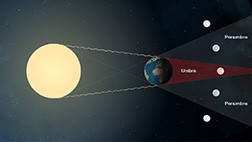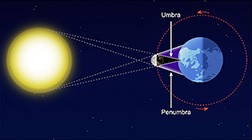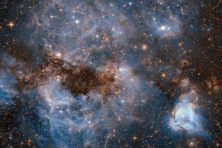Eye On the Night Sky: Upcoming Lunar Eclipse
- Share
- Tweet
- Pin
- Share

Lunar eclipse sideview. Submitted image.
The Lunar Eclipse has, throughout history and cultures, been subject of myth and legend. At varying times and circumstances they have been signs of both good and evil omens. Eclipses have been used to predict the life or death of monarchs or the results of battles.
In 1504, Columbus was able to consult his Calendarium and used the prediction of a total lunar eclipse to save his crew from starvation. Stranded in Jamaica, Columbus and crew had worn out their welcome. After six months, the Jamaican indigenes had begun to hold back food and water in an effort to get them to depart. Columbus threatened the natives with famine and disease using a “sign” from heaven of the darkening and reddening of the full moon unless they were supplied. The Eclipse occurred and the threat resulted in the Jamaican chiefs promising to supply the crew as long as needed.
As you see, Astronomers have been able to predict lunar eclipses for a long time. But this goes as well for Solar Eclipse. When total solar eclipses occur, they are visible to only about a half a percent of the Earth’s surface! Total solar eclipses occur only once every one to two years. The next total solar eclipse visible in the U.S. will be Aug. 21, 2017 and closest location to Door County is Carbondale, Illinois.
About 15 lunar eclipses occur every decade with about half being total – the entire moon enveloped in earth’s shadow. The next lunar eclipse, a total eclipse, will occur on the night of Sept. 27 and early morning of Sept. 28.

Solar eclipses occur at the New Moon when the moon passes between Earth and the Sun. Total eclipses are visible where the darkest part of the Moon’s shadow (umbral shadow) sweeps across the Earth. Submitted image.
The penumbra begins at 7:12 pm CDT. Penumbral is the term used for the time the moon darkens as the earth’s shadow blocks some of the sunlight. The partial eclipse (actual shadow) begins at 8:07 pm as the moon passed into the umbra of the earth. Total eclipse begins at 9:11 pm with mid-eclipse at 9:47 pm and lasts until 10:23 pm. Then the penumbra ends at 12:22 pm on Sept. 28! [See the diagram for a better explanation of the terms].
The Door Peninsula Astronomical Society (DPAS) is planning a viewing for the night of Sept. 27 starting at 7 pm. So if the sky is clear, join us at the L.E.O. Observatory, 2200 Utah St., for a view through a variety of telescopes and binoculars to see this celestial event.
The September meeting of DPAS will be Tuesday, Sept. 1 at 7 pm and the topic is “How Astronomers Measure Size and Distance” presented by David Udell and “Latest News in Astronomy” will be presented by Dr. John Beck.
Hope to see you then and at the observatory on the Lunar Eclipse!



